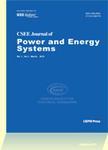版权所有:内蒙古大学图书馆 技术提供:维普资讯• 智图
内蒙古自治区呼和浩特市赛罕区大学西街235号 邮编: 010021

作者机构:The State Key Laboratory of Advanced Electromagnetic Engineering and Technology School of Electrical and Electronic Engineering Huazhong University of Science and Technology Wuhan430074 China
出 版 物:《CSEE Journal of Power and Energy Systems》 (CSEE J. Power Energy Syst.)
年 卷 期:2022年第11卷第3期
页 面:1107-1117页
核心收录:
基 金:This work was supported in part by the Joint Fund of the National Natural Science Foundation of China (No. U1866601).This work was supported in part by the Joint Fund of the National Natural Science Foundation ofChina (No. U1866601). The authors are with the State Key Laboratory of Advanced Electromagnetic Engineering and Technology, School of Electrical and Electronic Engineering, Huazhong University of Science and Technology, Wuhan 430074, China (e-mail: orchidwan@hust.edu.cn yuanxm@hust.edu.cn j.hu@hust.edu.cn)
摘 要:Frequency and voltage dynamics, as the focus of power systems, depends more and more on the frequency and amplitude response characteristics of renewable energy devices being subjected to power imbalance. Doubly-fed induction generator (DFIG)-based wind turbine (WT) is representative of renewable energy devices and shows different characteristics from those of conventional synchronous generator (SG). Unfortunately, the individual characteristics ofWT during system frequency and voltage dynamics are not intuitively illustrated by the existing structure-oriented models. Therefore, this paper aims to propose a function-oriented modeling methodology by representing inertia-controlled DFIG-based WT as internal voltage frequency and amplitude solely stimulated by active and reactive power imbalance. The individuality of characteristics is demonstrated that with grid voltage detection-based controls the internal voltage depends yet solely on power imbalance of WT, just like the case of SG. Through the infinity gain equivalence of the fast-electromagnetic loops, a simplified analytical model illustrating the electromechanical characteristics ofWT is further proposed. Based on the model, the similarities and differences between the characteristics of WT and SG are recognized. Simulation results for verification are also presented. © 2022 China Electric Power Research Institute. All rights reserved.